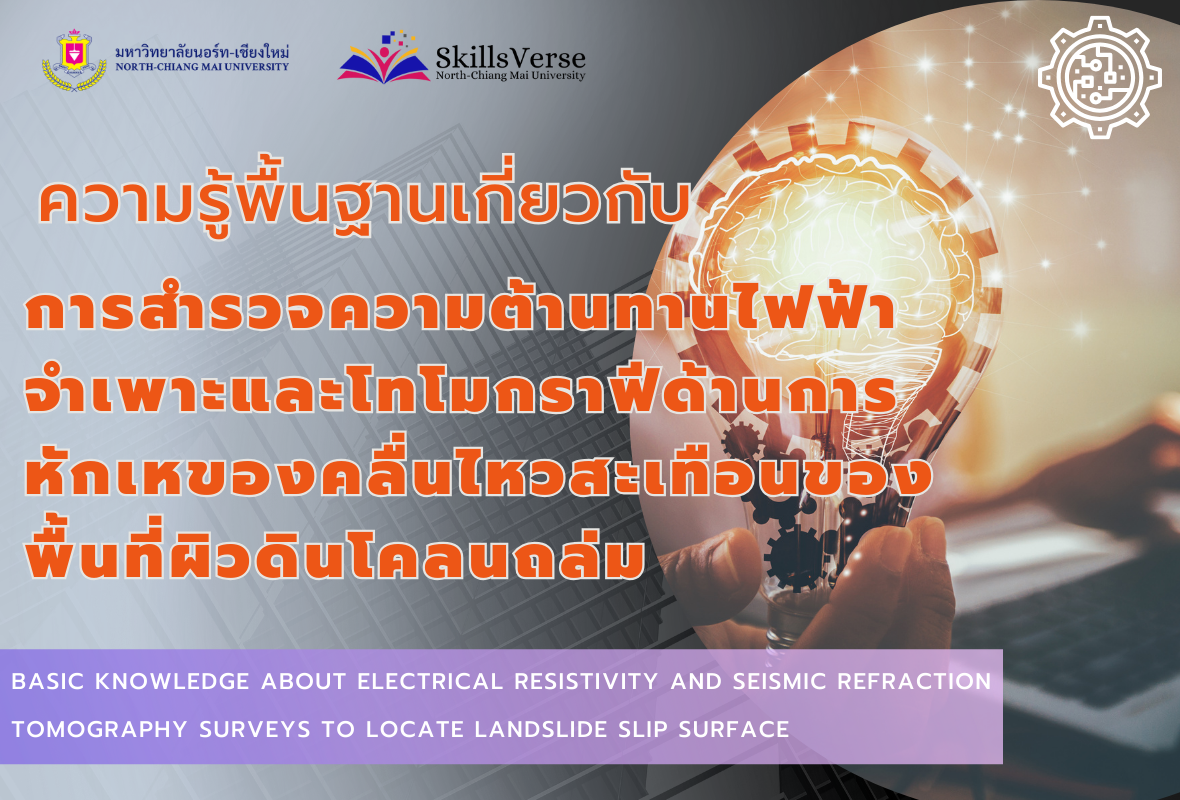ความรู้พื้นฐานเกี่ยวกับการสำรวจความต้านทานไฟฟ้าจำเพาะและโทโมกราฟีด้านการหักเหของคลื่น ไหวสะเทือนของพื้นที่ผิวดินโคลนถล่ม
Basic knowledge about Electrical Resistivity and Seismic Refraction Tomography Surveys to locate landslide slip surface

-
ผู้สอน
 อาจารย์รณชัย แพทย์ไชโย
อาจารย์รณชัย แพทย์ไชโย
-
Lecturer

รายละเอียด
Detail
-
การสร้างแบบจำลองความเร็วคลื่นโทโมกราฟี่ด้านการหักเหของคลื่นไหวสะเทือน ประโยชน์ดังนี้
1) เพื่อประเมินลักษณะโครงสร้างทางธรณีวิทยาของพื้นที่เสี่ยงแผ่นดินถล่ม ดังนั้นจึงมีการศึกษา ติดตาม (Monitoring) และใช้เป็นข้อมูลในการวางแผนตัดสินใจในการการเฝ้าระวังพื้นที่เสี่ยงภัย การกันเขตชุมชนออกจากพื้นที่เสี่ยง และการให้ความรู้ความเข้าใจแก่ประชาชน
2) เพื่อให้ความรู้ ความเข้าใจที่ถูกต้องกับบุคลากรที่ทำหน้าที่ในการเฝ้าระวัง พื้นที่เสี่ยงภัย
3) เป็นวิธีการสำรวจที่มีความน่าเชื่อถือสูง รวดเร็ว แปลผลง่าย ประหยัด เมื่อเปรียบเทียบ กับวิธีอื่นๆ นอกจากนี้ข้อมูลดังกล่าวจะสามารถเป็นกรณีศึกษาสำหรับชุมชนอื่นๆ สามารถแลกเปลี่ยนเรียนรู้
มีการใช้ประโยชน์จากความรู้ที่เกิดขึ้นได้อย่างเต็มประสิทธิภาพเพื่อให้
1) ชุมชนสามารถเก็บองค์ความรู้ไว้กับชุมชนตลอดไป
2) ช่วยให้ชุมชนแต่ละแห่งสามารถปรับตัวเข้ากับสิ่งแวดล้อมในปัจจุบันได้อย่างเหมาะสม
-
The creation of a seismic wave tomography model for the refraction of seismic waves has the following benefits:
1. To assess the geological structure of landslide-prone areas: This involves conducting studies and monitoring, using the data for decision-making in disaster risk management. It helps in identifying risk zones, separating communities from hazardous areas, and educating the public to raise awareness and understanding of the risks involved.
2. To provide accurate knowledge and understanding to personnel responsible for monitoring risk areas: This model ensures that personnel are well-equipped with accurate information regarding the geological conditions and potential hazards, enhancing their capacity to make informed decisions in disaster prevention and mitigation.
3. As a highly reliable, rapid, simple to interpret, and cost-effective surveying method: Compared to other methods, this approach offers significant advantages in terms of reliability, speed, ease of interpretation, and cost efficiency. Additionally, the collected data can serve as case studies for other communities, fostering mutual learning and knowledge exchange.
The knowledge gained from this process can be fully utilized to ensure:
1. Communities can retain knowledge within the community: This ensures that the insights and data gathered are kept within the community, allowing for sustainable disaster risk management practices to be passed on to future generations.
2. Each community can adapt appropriately to the current environment: The model enables communities to adapt to their unique environmental conditions, ensuring that responses to natural hazards are both effective and suitable to the local context.

 อาจารย์รณชัย แพทย์ไชโย
อาจารย์รณชัย แพทย์ไชโย 